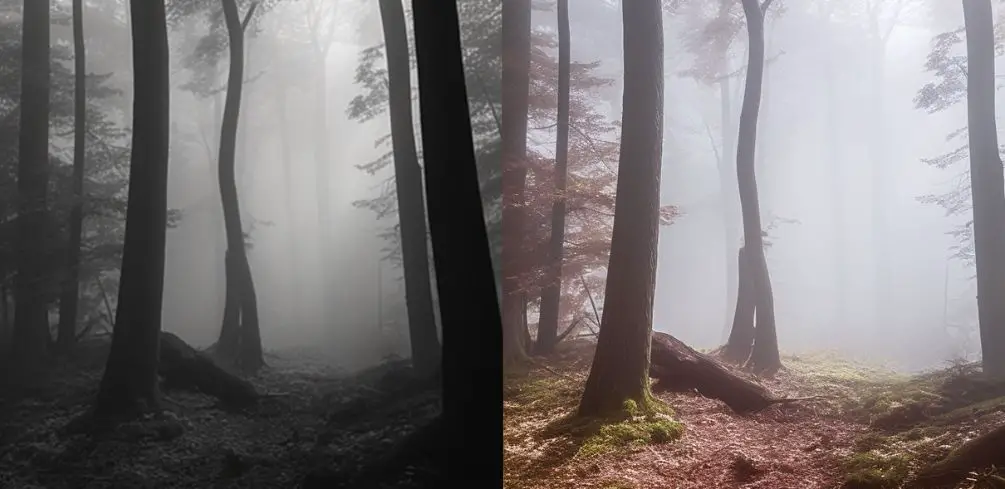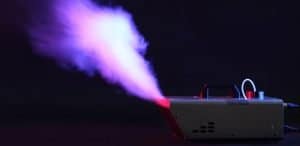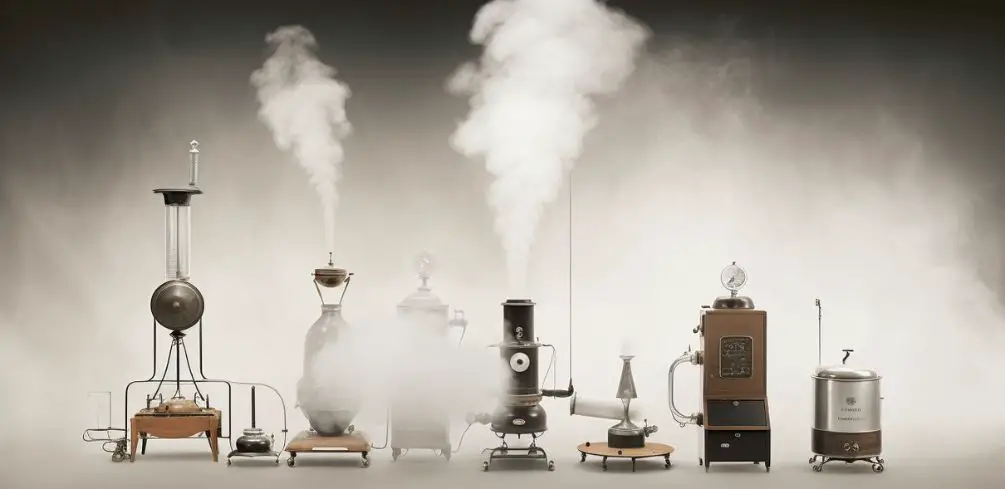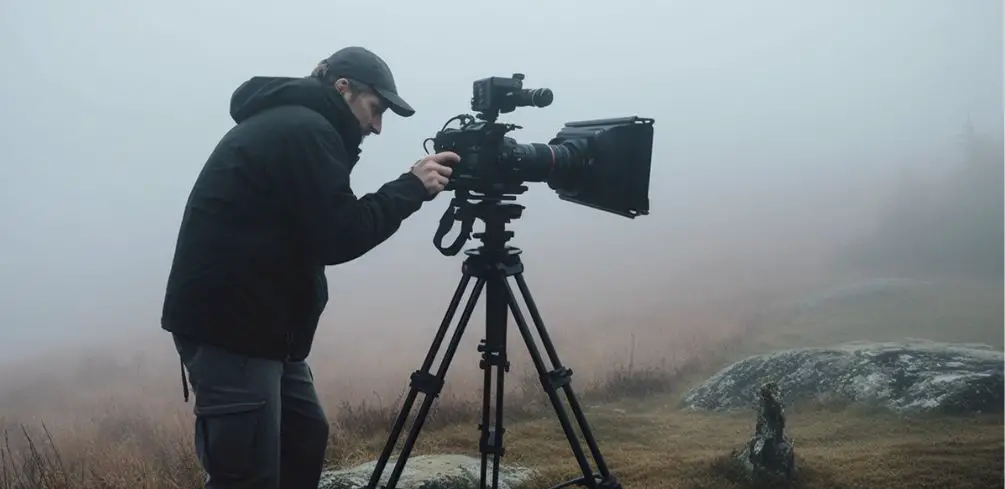Imagine a world where cotton candy clouds descend from the heavens, blanketing the earth in a soft, ethereal embrace. These wispy tendrils of fog weave through the landscape, transforming ordinary scenes into mystical realms filled with intrigue and wonder.
But what if you could harness this atmospheric phenomenon at will? Enter fog machines – devices that can conjure up their own version of Mother Nature’s handiwork to add drama and ambiance to any event or production.
In this article, we will delve into the fascinating science behind natural fog formation and artificial fog production, comparing their unique qualities and applications.
The Science Behind Natural Fog Formation

You might be curious about how natural fog forms in the environment, and the science behind it is quite fascinating. Fog composition is essentially made up of tiny water droplets or ice crystals suspended in the air, reducing visibility significantly.
The formation of fog is primarily influenced by two factors: temperature and humidity.
When these two factors meet under certain conditions, it creates an environment conducive to fog formation. Visibility effects caused by fog can vary depending on the density of those tiny water droplets or ice crystals within the air; denser fogs will reduce visibility more dramatically than lighter ones.
Temperature influence plays a crucial role in this process as well; when warm air meets colder surfaces, such as the ground or bodies of water, it cools down rapidly and condenses into small droplets, which make up fog.
Humidity factors are also essential for creating fog – if there isn’t enough moisture in the atmosphere for condensation to occur, then no matter how perfect the temperatures may seem, you won’t see any fog forming.
Fog dissipation occurs when conditions that initially allowed its formation change – a shift in temperature or humidity can help break up those tiny water droplets back into vapor form and disperse them back into the atmosphere.
This process typically happens naturally over time as daylight warms up surfaces causing higher evaporation rates and consequently breaking down dense patches of fog.
Alternatively, increased wind speeds can also facilitate quicker dispersal by thinning out areas of high humidity and encouraging evaporation. Understanding these natural processes allows us to better predict when and where we might encounter reduced visibility due to nature’s whimsical display of atmospheric artistry known as natural fog formations.
Understanding Artificial Fog Production
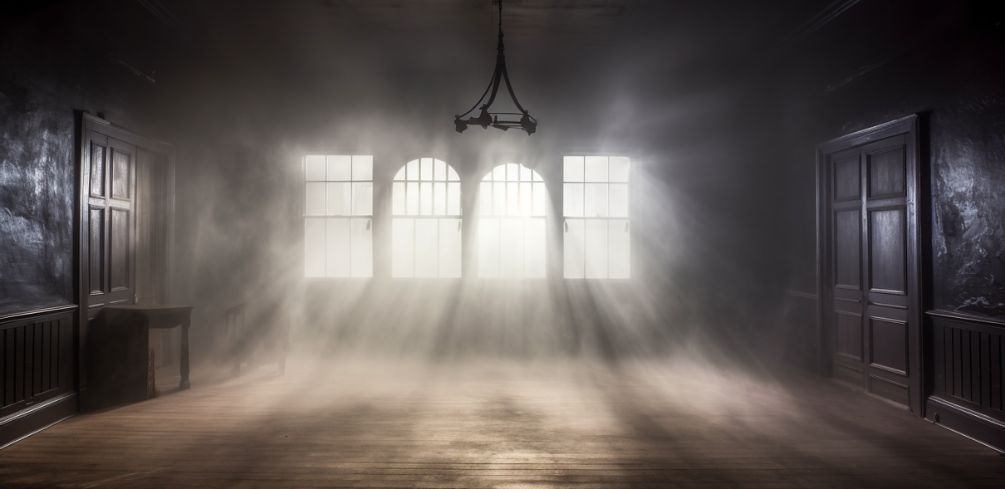
Diving into the world of artificial fog production, you’ll uncover an array of fascinating techniques and technologies that create those mysterious, enchanting atmospheres. Fog chemicals play a crucial role in generating the desired fog effect, with propylene glycol or glycerin being popular choices due to their non-toxic nature.
These substances are mixed with water to form a specialized fog fluid that is then vaporized by a fog machine, creating an atmosphere reminiscent of natural fog.
In addition to commercial solutions, DIY fog solutions can be concocted using household ingredients like distilled water and food-grade glycerin.
Fog machine maintenance is vital for ensuring the optimal performance and longevity of your device. Regular cleaning helps prevent residue buildup within the heating element and tubing that could otherwise impede proper functionality.
This includes thoroughly flushing out the system with distilled water after each use, as well as periodically disassembling and cleaning individual components when necessary. Moreover, adhering to recommended fog safety precautions is essential for both health considerations and maintaining equipment integrity.
This entails storing chemicals according to manufacturer guidelines, refraining from inhaling directly from the output nozzle, and not leaving machines unattended while in operation.
Beyond typical event settings like concerts or theatrical performances, unique fog applications continue to emerge across various industries due to their captivating visual appeal and practical uses.
For example, photographers often employ artificial fog as a tool for enhancing depth perception or creating moody backdrops in their compositions; theme parks may utilize it for simulating eerie environments within haunted houses or dark rides; even emergency response training exercises might incorporate controlled amounts of artificial fog for recreating realistic disaster scenarios where visibility is compromised.
As technology advances further within this domain, creative minds will undoubtedly continue devising innovative ways in which artificial fog production can enrich our experiences across multiple disciplines.
Advantages and Disadvantages of Each Type

Now let’s explore the pros and cons of various artificial fog production methods, so you can determine which type best suits your needs and preferences. When comparing natural fog to artificial fog machines, it’s essential to consider factors such as:
- Fog safety
Natural fog forms through a natural process and doesn’t have any added chemicals or substances that may be harmful. Fog machines produce artificial fog by heating water and glycol, which might cause irritation in some individuals when exposed for extended periods.
- Fog aesthetics
Natural fog provides an authentic look and feels for outdoor events or photography sessions where capturing the essence of nature is desired. Artificial fog can be easily controlled, allowing for precise adjustments in density and distribution to create the perfect ambiance or effect required.
- Visibility challenges
While both types of fog can create visibility challenges, natural fog may vary in intensity based on weather conditions, making it more unpredictable than artificial options.
One must weigh the advantages against the potential health implications associated with each type of fog. For instance, while some people find the smell of artificial fog enjoyable as it enhances their experience at concerts or haunted houses, others might experience respiratory discomfort due to exposure.
On the other hand, natural fog has little to no impact on human health unless it carries pollutants from nearby sources.
When considering navigation aspects during events involving either type of fog, remember that both present unique obstacles. Artificially produced fogs allow event organizers to control their presence and density; however, if not managed correctly or if equipment malfunctions lead to excessive output levels could result in disorientation among attendees.
Meanwhile, navigating a ship through naturally occurring fogs depends heavily on weather conditions; a sudden increase in intensity might disrupt outdoor activities without proper preparation.
As you choose between these two options for your event or project environment requirements, keep these factors in mind so you make an informed decision based on practicality alongside aesthetic preferences.
Environmental Impacts and Concerns
It’s crucial to consider the environmental impacts and concerns when deciding on which type of fog production method to use for your needs.
Both natural fog and artificial fog from fog machines have varying effects on climate change, wildlife disruption, air quality, water conservation, and energy consumption.
By understanding these factors, you can make an informed decision that is both practical and environmentally responsible.
Natural fog plays a critical role in maintaining ecological balance by providing moisture to plants and animals while also helping regulate temperature. However, it may be negatively impacted by climate change as rising temperatures can lead to reduced fog formation or altered distribution patterns.
This could result in potential disruptions to local ecosystems or even species extinction if wildlife relying on fog for survival cannot adapt quickly enough.
On the other hand, artificial fog from machines relies heavily on energy consumption for operation – which contributes to greenhouse gas emissions – as well as the use of chemicals such as glycerin or propylene glycol that can negatively impact air quality if not properly managed.
When considering water conservation efforts, natural fog does not require any additional resources apart from what nature provides; however, artificial methods may consume large amounts of water depending on the specific type of machine being used.
Moreover, while traditional heating-based machines may consume more energy than their newer ultrasonic counterparts – with some models requiring up to 1 kW per hour of usage – they still contribute significantly less than most industrial processes or large-scale events (such as concerts) where multiple high-wattage devices are deployed simultaneously.
As you assess your options for generating atmospheric effects at your event or location, remember that making an eco-friendly choice involves evaluating the direct consequences of each method while also acknowledging their broader implications within our planet’s delicate ecosystem balance system.
Comparing Their Roles in Events and Ecosystems

When it comes to events and ecosystems, there’s a world of difference between natural misty landscapes and the billowing clouds created by artificial fog machines. In this comparison, you’ll learn how each type of fog plays unique roles in event aesthetics and ecosystem balance.
Let’s dive deep into these two contrasting aspects of fog to provide you with a better understanding.
- Event aesthetics: Natural fog can add an air of mystery or enchantment to outdoor events such as weddings, concerts, or photoshoots. On the other hand, artificial fog from machines allows for more control over the thickness and duration at indoor events like theater performances or parties.
- Ecosystem balance: Foggy weather conditions contribute to a balanced ecosystem by providing moisture that nourishes plant life and aids in maintaining humidity levels necessary for various wildlife adaptations. Conversely, artificially generated fog does not have any significant impact on ecosystem health but may cause local fluctuations in visibility factors.
- Health implications & wildlife adaptation: While natural fog is generally harmless (unless it contains pollutants), artificial fog can sometimes pose health risks due to chemicals used in manufacturing the fluid that creates the vapor; this may be especially concerning for people with respiratory issues or allergies. Similarly, some studies suggest that artificial fog can potentially disrupt wildlife behavior patterns due to sudden changes in visibility factors.
As we’ve seen through this analysis, both natural and man-made fogs have their distinct roles within events and ecosystems – one contributing positively towards environmental well-being while the other elevates entertainment experiences with its controlled usage.
By understanding these differences between nature’s delicate touch versus human ingenuity, we gain a greater appreciation for each type of misty phenomenon while becoming better equipped to make informed decisions about their use during our own special occasions or daily lives alike.
Frequently Asked Questions
How does the visibility of natural fog differ from that of artificial fog produced by fog machines?
When examining fog composition and its visibility effects, it’s essential to consider how natural fog differs from artificial fog produced by machines in terms of density and dispersion.
Natural fog is formed through a complex process involving the cooling of air, condensation, and humidity. Artificial fog, on the other hand, is created using glycol or glycerin-based fluids that are vaporized by heating elements within fog machines.
As a result, natural fog tends to disperse more slowly and may have longer-lasting effects on visibility compared to artificial fog, which can dissipate quickly if not continuously replenished.
Additionally, machine-generated fog usually requires periodic maintenance to ensure proper functionality and consistent output.
Overall, understanding these distinctions can help you better anticipate and navigate the unique challenges posed by each type of fog while also satisfying your innate curiosity about the world around you.
Are there any health risks associated with exposure to artificial fog compared to natural fog?
Imagine walking into a room filled with fog, unsure of what awaits you on the other side – but should you be more concerned about the potential impact on your health?
Respiratory protection is crucial, especially for those with sensitivities to allergy triggers or a history of asthma exacerbation. Artificial fog produced by fog machines can contain glycol-based chemicals or mineral oil that may irritate respiratory systems and lead to worsened indoor air quality.
While natural fog poses little risk in comparison, it’s essential to consider fog alternatives when planning events or performances if you want to ensure the safety and comfort of all attendees.
So next time you find yourself enveloped in a mysterious haze, take a moment to consider its source before stepping further into the unknown.
Can the use of fog machines in outdoor events have any impact on local wildlife?
When planning an outdoor event, it’s important to consider the potential impact of using fog machines on local wildlife and their behavior. Fog machine maintenance and proper fog dispersal methods play a crucial role in minimizing any environmental impact.
While some species may exhibit short-term behavioral changes due to the sudden appearance of artificial fog, many animals have strong adaptation skills that allow them to cope with such alterations in their surroundings. Nevertheless, if you’re concerned about possible consequences for wildlife, you might want to explore event alternatives that don’t involve the use of fog machines or take additional precautions to minimize disturbances.
By being aware of these factors and making informed decisions, you can help ensure your event is both memorable and environmentally responsible.
Are there different types of natural fog and artificial fog?
Imagine the serendipitous moment when you find yourself surrounded by a mysterious, ethereal fog. In such instances, it’s intriguing to understand the differences between natural and artificial fog.
Fog composition varies greatly between these two sources, with natural fog forming through condensation in the atmosphere, while the artificial fog is typically created using glycol or glycerin-based solutions. Fog dispersal also differs; natural fogs can linger for hours as they depend on temperature and humidity changes to dissipate, whereas artificial fogs have a shorter lifespan due to their chemical makeup and environmental conditions.
Despite their transient nature, artificial fog benefits include precise control over density and duration, which can enhance visual effects during events or performances. However, fog machine limitations include potential health hazards if not properly maintained or if low-quality fluids are used.
Ultimately, exploring the diverse characteristics of natural and artificial fogs deepens our appreciation for this captivating phenomenon that has both practical applications and aesthetic appeal.
How has the technology of fog machines evolved over time?
Over the years, fog machine history has witnessed remarkable advancements in technology, leading to sustainable fog production that closely mimics the aesthetics of natural fog.
As you delve into the world of artificial fog, you’ll find that modern devices offer an impressive range of natural fog simulations by utilizing various methods such as vaporizing glycol-based fluids or ultrasonic vibrations to create mist.
With ongoing research and development, it’s likely that even more innovative solutions are on the horizon to further enhance this simulation while maintaining a focus on sustainability.
Additionally, contemporary fog machines boast user-friendly maintenance features to ensure their longevity and optimal performance, testament to the industry’s commitment not only to creating immersive experiences but also promoting hassle-free operation for users who appreciate detail-oriented design and engineering.
Conclusion
In the dance of mists, nature’s fog weaves a delicate tapestry, telling the story of balance and harmony. You witness Earth’s gentle breaths as they blanket landscapes, shrouding secrets and mysteries in their embrace.
Yet, man-made fog machines add an artificial touch to this symphony, painting vivid scenes for events and performances. As you marvel at both forms of haze, remember that understanding their impact is key to preserving the essence of our world’s enigmatic beauty.

